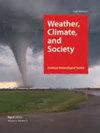Understanding Broadcast Meteorologists’ Current and Future Use of Severe Weather Watches, Warnings and Probabilistic Hazard Information
IF 1.9
4区 地球科学
Q3 ENVIRONMENTAL STUDIES
引用次数: 0
Abstract
Broadcast meteorologists are essential in the communication of National Weather Service (NWS) warnings to the public. Therefore, it is imperative to include them in a user-centered approach for the design and implementation of new warning products. Forecasting a Continuum of Environmental Threats (FACETs) will modernize the way meteorologists forecast and communicate NWS warning information to the general public using rapidly updating probabilistic hazard information (PHI). Storm scale PHI consists of probabilistic forecasts for severe wind/hail, tornadoes, and lightning hazards. Hence, NWS warnings would have the capacity to be supplemented by a quantitative or qualitative likelihood of hazard occurrence. The researchers conducting this study wanted to know what broadcast meteorologists thought about the inclusion of this likelihood information and how it could impact their decision making and communication process. Using a nationwide survey, this team of researchers first asked broadcast meteorologists about their current practices for severe weather coverage using NWS watches and warnings. Next, broadcast meteorologists were introduced to multiple iterations of PHI prototypes and queried for their input. Findings indicated that broadcast meteorologists already face a complex decision making and communication process under today’s warning paradigm. Additionally, respondents were split on whether to explicitly communicate probabilities with their viewers. Respondents’ choices were also somewhat inconclusive regarding nomenclature, definitions of PHI and representations of PHI with warning polygons. These results suggest that PHI should feature user-driven, customizable options to fulfill broadcast meteorologists’ needs and that the iterative nature of the research-and-development process of PHI should continue.了解广播气象学家当前和未来对恶劣天气观测、警告和概率危险信息的使用
广播气象学家在向公众传达国家气象局(NWS)警告方面至关重要。因此,在设计和实施新的警告产品时,必须将它们纳入以用户为中心的方法中。预测环境威胁的连续性(FACET)将使气象学家使用快速更新的概率危险信息(PHI)预测NWS警告信息并将其传达给公众的方式现代化。风暴级PHI包括强风/冰雹、龙卷风和闪电危险的概率预测。因此,NWS警告有能力通过危险发生的定量或定性可能性进行补充。进行这项研究的研究人员想知道广播气象学家对包含这种可能性信息的看法,以及它如何影响他们的决策和沟通过程。通过一项全国性的调查,该研究小组首先询问了广播气象学家,他们目前使用NWS手表和警告进行恶劣天气覆盖的做法。接下来,广播气象学家被介绍给PHI原型的多次迭代,并询问他们的输入。研究结果表明,在今天的预警模式下,广播气象学家已经面临着复杂的决策和沟通过程。此外,受访者在是否与观众明确交流概率的问题上存在分歧。受访者的选择在命名法、PHI的定义以及带有警告多边形的PHI表示方面也有些不确定。这些结果表明,PHI应该以用户驱动、可定制的选项为特色,以满足广播气象学家的需求,并且PHI的研究和开发过程的迭代性质应该继续下去。
本文章由计算机程序翻译,如有差异,请以英文原文为准。
求助全文
约1分钟内获得全文
求助全文
来源期刊

Weather Climate and Society
METEOROLOGY & ATMOSPHERIC SCIENCES-
CiteScore
3.40
自引率
13.60%
发文量
95
审稿时长
>12 weeks
期刊介绍:
Weather, Climate, and Society (WCAS) publishes research that encompasses economics, policy analysis, political science, history, and institutional, social, and behavioral scholarship relating to weather and climate, including climate change. Contributions must include original social science research, evidence-based analysis, and relevance to the interactions of weather and climate with society.
 求助内容:
求助内容: 应助结果提醒方式:
应助结果提醒方式:


